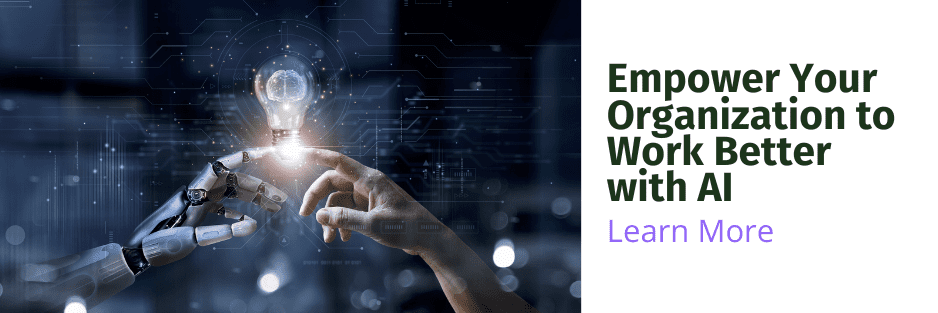Navigating the Convergence of Human Expertise and Technological Advancement
As AI and automation continue evolving, businesses must adapt their strategies, processes, and talent to most effectively harness these tools while retaining a human touch.
Artificial intelligence (AI) and automation are transforming multiple industries and business functions — from consulting and HR to IT purchasing decisions. Some worry that this technology may become self-aware and threaten humanity, but we’re nowhere near a future suggested by the cautionary tale of Skynet.
AI and automation do offer tremendous potential for efficiency gains and data-driven insights, but these technologies cannot wholly replace human skills and contextual decision-making. Companies combining AI capabilities with human expertise in a hybrid model stand to realize the greatest benefits.
As AI and automation continue evolving, businesses must adapt their strategies, processes, and talent to most effectively harness these tools while retaining a human — and necessary — touch.
AI Disrupts the Consulting Industry
Will AI take over the consulting roles? No — but it will augment them. Half of mid-sized businesses already use AI to choose software, with 70% saying this tool helps save time and money compared to working with traditional consultants. The reality is that consultants, while insightful, can miss the unique intricacies of an organization’s specific needs, leading to poor user adoption and misaligned stakeholder requirements.
But AI cannot generate contextual advice for dynamic situations or make nuanced judgments and recommendations because knowledge extends beyond the data AI is trained on. AI can, however, tap into company data, past projects, and applicable skills to match team members and consultants with the right experience to address challenges.
Unless the industry adapts to working alongside modern tools, AI could kill traditional consulting. The industry must reinvent itself to remain competitive and harness the power of combining both human expertise with AI-driven decision-making tools, which increase consultants’ effectiveness and efficiency and lead to better client outcomes.
HR in the Era of Digitalization: Harnessing Efficiency and Insight
HR Digital Transformation Trends
Factors like changing workforce dynamics and technological advancements drive the constant evolution in the HR field. HR professionals have embraced AI and automation, recognizing their potential to revolutionize various operational aspects, from recruitment and onboarding to employee engagement and performance management.
HR will continue leaning into HR Technology and AI-powered tools to automate repetitive manual tasks, enhance data analytics capabilities, and streamline administrative processes. Adopting and implementing AI will free HR teams to focus on strategic initiatives and gain insights via predictive analytics into employee development, engagement, performance, and retention.
Digital Transformation in Healthcare: Revolutionizing Patient Care
Healthcare Digital Transformation Trends
In the realm of healthcare, digital transformation is poised to revolutionize patient care delivery and outcomes. From electronic health records (EHR) systems that streamline data management to telemedicine platforms enabling remote consultations, technology is reshaping every facet of the healthcare ecosystem. AI-powered diagnostic tools are enhancing the accuracy and speed of medical diagnoses, while wearable devices and health monitoring apps empower individuals to take charge of their well-being. As healthcare providers embrace digital innovation, patients can expect more personalized, efficient, and accessible healthcare experiences, ultimately leading to improved health outcomes and enhanced patient satisfaction.
Digital Transformation in Manufacturing: Optimizing Operations and Efficiency
Digital transformation in Manufacturing is synonymous with operational optimization and efficiency gains. Through the adoption of advanced robotics, IoT sensors, and predictive analytics, manufacturers can unlock new levels of productivity while minimizing downtime and waste. Real-time data insights enable proactive maintenance, ensuring that equipment operates at peak performance and reducing the risk of costly breakdowns. Furthermore, digital twins and simulation technologies allow manufacturers to simulate and optimize production processes, accelerating innovation and time-to-market. By embracing digital transformation, manufacturing firms can achieve greater agility, flexibility, and competitiveness in today’s dynamic marketplace.
Digital Transformation in Retail: Enhancing Customer Experiences
Retail Digital Transformation epitomizes the enhancement of customer experiences and the propulsion of omnichannel engagement within the retail landscape. E-commerce platforms powered by AI-driven recommendation engines personalize product offerings, catering to individual preferences and behaviours. Augmented reality (AR) and virtual reality (VR) technologies revolutionize the shopping experience, allowing customers to visualize products in their own environments before making purchasing decisions. Moreover, data analytics and machine learning enable retailers to gain deep insights into consumer trends and behaviours, facilitating targeted marketing campaigns and dynamic pricing strategies. By leveraging digital innovation, retailers can create seamless, immersive shopping experiences that resonate with today’s tech-savvy consumers, fostering brand loyalty and driving revenue growth.
Navigating the Complex Terrain of IT Decision-Making
Surveys show that IT spending is shifting, with over half of enterprise and mid-market organizations planning to increase IT budgets in 2024. That said, companies are moving into more complex buying processes, with an average of 22 roles on a buying committee involved in purchasing software. Those roles might include C-suite execs, department leads, end users, internal influencers, legal team users, and IT departments.
If you tried to map the journey, you wouldn’t see a linear path or an easy flowchart, either. Instead, the journey would resemble a maze of back-and-forth between stakeholders at various stages, from problem identification and solution exploration to requirements building and supplier selection, before ever reaching the purchase decision stage.
And with more decision-makers comes more potential headaches — for companies and vendors — reaching a consensus may become even more difficult. We’re seeing the final decision come down to the C-suite executives as SaaS solutions have evolved to use low- or no-code technologies that don’t require specific, in-depth expertise for onboarding and set-up.
The time to purchase is still fairly lengthy, with about 33% of buyers needing 4-6 months to finalize purchases of $20,000 or more. Most buyers (80%) planning a large software purchase ($20,000+) pull the trigger in fewer than six months. Negotiation times last longer now than legal review, too, with the average negotiation time of 22 days and legal review of 11 days.
Buyers are becoming cautious about basing purchases solely on information found on a particular vendor’s website. They’re seeking other external, credible sources — like professional networks, market reports, recommendations, and user-generated content via online communities, review sites, and social media platforms — to get data and gather insights for informed decision-making.
Once they’ve shortlisted their options, buyers are looking beyond features and pricing. They’re interested in user-friendliness, ease of implementation, customer support quality, ROI, and level of data security. B2B SaaS buyer behaviour will continue to evolve and, thus, influence how software sellers approach how they present their products in this very competitive industry.
Fostering Synergy Between Humanity and Technology
Amidst the ongoing discourse surrounding the ethical implications of AI and automation, it is imperative to recognize that these technologies are neither panaceas nor existential threats. Rather, they represent potent tools that, when wielded judiciously, can augment human potential and propel us towards collective progress.
By fostering a culture of collaboration and inclusivity, wherein human creativity converges harmoniously with technological innovation, organizations can unlock new frontiers of possibility. Whether it be revolutionizing user experiences, optimizing supply chain logistics, or advancing scientific discovery, the synergy between human ingenuity and technological prowess holds the key to addressing society’s most pressing challenges.

Embracing the Journey Towards Digital Transformation
In summation, the digital transformation trends unfurling in 2024 are not transient phenomena but enduring catalysts driving the future of work and commerce. By embracing the boundless possibilities afforded by AI and automation, organizations can chart a course towards sustainable growth, competitive differentiation, and societal impact.
As we embark on this transformative journey, let us remain steadfast in our commitment to ethical stewardship and responsible innovation. By harnessing the transformative power of AI and automation for the greater good, we can usher in a future where human potential knows no bounds, and technological innovation serves as a beacon of progress and prosperity.
A shorter version of this post originally appeared on RTInsights.com.
More Digital Transformation Insights and Resources from Olive







